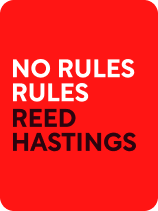

This article is an excerpt from the Shortform book guide to "No Rules Rules" by Reed Hastings. Shortform has the world's best summaries and analyses of books you should be reading.
Like this article? Sign up for a free trial here .
Are 360-degree reviews effective at Netflix? Would you give criticism to a coworker if your name was attached to it?
Reed Hastings, Netflix’s co-founder and CEO, wrote about his 360-degree assessment process in his book No Rules Rules. At first, Hastings believed that written, anonymous feedback would be given to each employee. But later, he decided that live feedback given from an employee’s coworkers was more effective.
Continue reading to learn about the evolution of Netflix’s 360-degree assessment process.
Process 1: Annual Written 360-Degree Reviews
Hastings wanted a formalized way for employees to receive feedback, but he felt that the standard performance review that many companies use had a glaring shortcoming: Feedback only goes from superiors to subordinates, missing insight from coworkers who work with you in a different capacity.
Instead of a traditional performance review, Hastings and the executive team thus implemented an annual written 360. (Shortform note: A “written 360” refers to a 360-degree assessment or review, which is also called multisource feedback, multi-rater feedback, or multisource assessment.) In the written 360, each employee receives written feedback from any colleague who wants to give it—including bosses, supervisors, coworkers, and subordinates. Comments must be actionable and constructive, and they should clearly describe what an employee should stop doing, keep doing, and start doing.
(Shortform note: This feedback mechanism is called the “SKS form.” It’s an effective tool not only in the workplace but also in your personal life, because it’s based on a spirit of respect and collaboration, and it helps improve relationships by making you aware of each other’s needs.)
The annual 360s are not tied to raises, promotions, or firings—rather, they’re purely meant to give each employee the opportunity to give and receive thorough feedback. The culture of candor dictates that there already should be a constant stream of feedback, but an annual 360 can give a more comprehensive evaluation. (Shortform note: Think of regular feedback as stretching every day, while the annual 360 is like getting an occasional deep-tissue massage—the periodic treatment allows you to address the knots and pains that a quick daily stretch can’t relieve.)
Despite Netflix’s open and honest culture, certain suggestions are hard for many people to give and receive, but those comments are often vital to improving someone’s performance—this process ensures that they don’t get glossed over.
(Shortform note: Make the most of 360s and the vital feedback they provide by following up with individuals to make sure that they understand the feedback. Then, work with them to transform the feedback into improved performance in three steps: First, make them aware of what they need to do to implement the feedback. Second, make sure they commit to making the necessary changes. And third, motivate them to change by setting goals for their improvement.)
Written 360s Are Not Anonymous
When Hastings first implemented the written 360s, he allowed anonymous comments so that people could feel comfortable being totally open. After a couple of years, Hastings struck the anonymous option and found that feedback became more concrete and turned into a springboard for more valuable discussions. Employees also put more effort into their comments, because their names and credibility were attached.
(Shortform note: If, contrary to Hastings, you find that feedback is more effective when given anonymously at your company, then this may be a sign of a bigger problem: a lack of trust among team members. Help employees understand that anonymity leads to reduced accountability, produces misleading results, and sends mixed messages. Then, assure them that any negative feedback they give in a named survey or evaluation won’t be held against them.)
Process 2: Live 360-Degree Reviews
Hastings saw that the biggest benefit of the written 360s was the discussions that grew out of the written comments, so he implemented face-to-face 360-degree reviews. In a live 360, a manager and her team gather for several hours and go around the room as each employee takes a turn receiving feedback. This format has two benefits:
1) It provides insight into the interpersonal dynamics of the team as a whole by enabling everyone to hear teammates’ comments about each other. If one person offers a suggestion, someone else can dispute or build on it, and the person receiving the feedback gets a sense of how she may be effective in one context but may need improvement in another area.
(Shortform note: Such open discussion about teammates’ flaws and areas for improvement may create some tension between the critic and the person being critiqued. While you want to manage this tension, some argue that having a little drama during a meeting is a good thing. In Death by Meeting, Patrick Lencioni writes that having disagreements keeps participants engaged, so you should actively look for signs of disagreement. Pay attention to comments and people’s facial expressions, and prod further when you notice that they’re trying to avoid conflict.)
2) Each employee becomes more accountable to her team, which improves the team’s overall effectiveness and collaboration. This also reinforces the principle of acting in the best interest of the company instead of merely trying to please the boss.
(Shortform note: While an employee’s attempts to please you may be ego-boosting, this kind of behavior can be disruptive. Not only does it take the employee’s time away from their actual work, but it can also cause friction among team members who may view their co-worker’s efforts as self-serving. Take care not to encourage this kind of behavior and get employees to refocus by letting them make decisions solo instead of constantly consulting you, having them work with other leaders, and giving everyone on your team the same amount of time and attention.)
Even if you’re acclimated to the company’s culture of candor, fielding constructive criticism from your entire team in front of your entire team can be daunting. However, no one aims to attack or embarrass their teammate—especially because they’ll also have a turn on the hot seat. The culture of autonomy and accountability also ensures that employees will call out a coworker whose comments are out of line. Meyer writes that some employees still see the process as uncomfortable and potentially embarrassing, but if they can be receptive to comments and avoid getting defensive, the feedback could save them from failing a manager’s future assessment.
| Make the Most Out of Live Feedback Sessions The idea of a live feedback session may seem more daunting than a written review because you see the other person’s reaction to your feedback in real-time. However, in Creativity, Inc., Pixar co-founder Ed Catmull writes that the advantages of a live session over a written one are that you have the power to control the tone of the discussion and give people the chance to ask follow-up questions. To make the most out of feedback sessions like a live 360, Catmull says you should first establish a safe, judgment-free environment. Remind employees that their feedback can help you address issues that may cause serious problems in the future, and reassure them that they won’t be punished for their opinions. Then, at the live sessions, you can further encourage people to speak and be more receptive by: Involving people who are passionate about the projects up for discussion. Because they’re invested in the projects, they likely won’t hold back from giving their opinion. Encouraging collaboration. Address flaws and areas for improvement without using personal attacks, then find ways to work together to find solutions. For example, instead of saying, “Why are your reports so disorganized?” you can say, “Your reports are a little disorganized, so let’s figure out how we can improve the content.” Offering suggestions instead of making demands. If you’re discussing a specific project, defer to the project manager when it comes to implementation. |

———End of Preview———
Like what you just read? Read the rest of the world's best book summary and analysis of Reed Hastings's "No Rules Rules" at Shortform .
Here's what you'll find in our full No Rules Rules summary :
- How Netflix achieved massive success in a short period of time
- The unusual business practices that have helped Netflix sustain its success
- Why Netflix fires adequate employees





